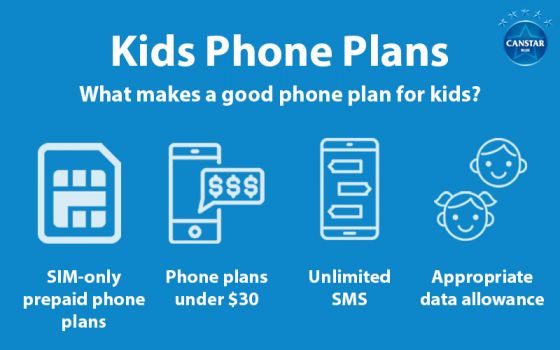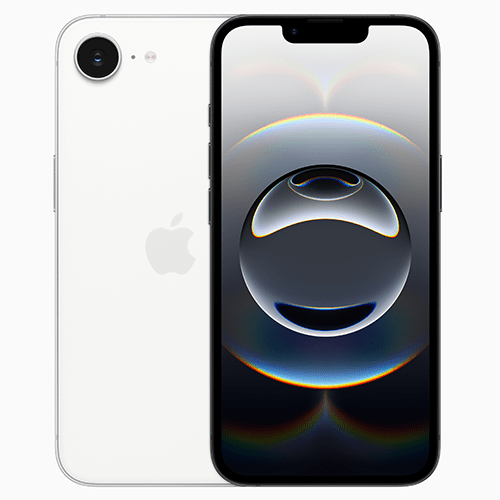Key points
- When comparing phone plans for your child, consider how much call, SMS and data inclusions your child will need.
- Providers including Spriggy Mobile and Yomojo have tailored family and kids plans while other telcos have plans available for under $30 per month.
- Prepaid and postpaid plans both have pros and cons , depending on your child’s preferences and needs.
If you’re a parent looking for a good phone plan for your child, you may be surprised to find that there are few plans actually tailored for children – after all, a phone plan is generally a phone plan, regardless of your age. However, some telcos offer kid-friendly phone plans, so if you’ve made the decision to give your child their first phone — or want to find a better deal than their current plan — you’ve come to the right place.
While some mobile virtual network operators (MVNOs) offer cheap phone plans, a few of them will offer additional incentives for the kids’ plans, such as access to cyber safety programs, which allow parents to monitor their child’s online activity.
On this page:
Compare the best kids phone plans
Before we talk about specific kids phone plans, here’s a quick glance at some cheap phone plans that might be suitable for your child. The following table shows a selection of prepaid plans from Canstar Blue’s database for under $40, listed in order of cost from lowest to highest, then by data allowance, largest to smallest. Use our comparison tool to see a wider range of plans from other providers. These are products with links to referral partners.
What to look for when choosing a kids mobile plan

When it comes to picking the kids phone plans, you’ll need to consider what type of phone user they will be. Will they be a light or heavy data user? Kids generally love to text and use data, but having a limit on calls is also hugely beneficial. Their age might also determine the inclusions they need — younger kids might use less data while teenagers are more likely to use more data. Therefore, consider the following as bare minimum requirements for a good phone plan for kids:
- Unlimited texts: No matter your child’s age, unlimited texts are a really good idea, because it means they will always be able to reach you in the event of an emergency and text their friends without exceeding any plan limits.
- Data limits and costs: A phone plan with at least 1GB of data should be enough for light use of basics like Google Maps, web browsing and using messaging apps. Heavier data use, especially social media apps with video, such as TikTok, will use a lot more data. Also consider any postpaid plans with cheap excess data rates (or no excess data charges), and with a usage warning system – for example, SMS alerts when 50%, 85%, and 100% of the monthly data allowance has been used.
- Longer expiry periods: Be wary of the expiry period of some cheap prepaid plans as these are sometimes only 7-10 days. Instead, look at prepaid plans with 28-30 day expiries, as this reduces the risk of your child having no credit to call or text you, while also taking away the hassle of recharging regularly. Those short-term plans might be cheap but consider how many times you’ll need to recharge each month, which can really add up.
Keep in mind that the type of features that best meet your child’s phone use may also be related to their age. Younger kids generally won’t need much data, while older teenagers more likely to use and therefore need much more data for video streaming, social media, and more. The good news is that there are lots of phone plans out there with reasonably big chunks of data for well under $50.
Prepaid offers you might like
The following table shows a selection of sponsored SIM Only plans on Canstar Blue’s database with links to referral partners.
 |
1 Month Contract (1 month min. cost $20) SIM Only Prepaid
|
Unlimited
GB |
$20.00 Cost/month |
Go to site |
 |
1 Month Contract (1 month min. cost $17.50) SIM Only Prepaid
|
50GB Data/month |
$17.50 Cost/month |
Go to site |
 |
1 Month Contract (1 month min. cost $17.50) SIM Only Postpaid
|
50GB Data/month |
$17.50 Cost/month |
Go to site |
Specific kids phone plans
These days its generally accepted that kids need their own phone plan and you might be looking for a specific kids SIM card. Several of the smaller telcos, most notably Yomojo, have recognised this and now offer specific phone plans ‘for kids’ at reasonably cheap prices and with extras such as cyber security, while other telcos, like Amaysim and Moose Mobile, offer simple, cheap plans that could be a good option. Below we’ll take a look at these telcos and the best phone plans for kids on offer in April 2025, including:
- Spriggy Mobile phone plans — designed for kids with parental controls
- Yomojo Family bundles
- Moose Mobile $26.80 SIM Only plan for $26.80 with 27GB data
- Dodo $23 SIM-only plan for $23 with 15GB data
Spriggy Mobile
Spriggy is well-known for its budgeting app and debit card for kids, but has now branched out into the mobile plan space. With the complexities and confusion that many parents and guardians may face around choosing the best phone plan for your child, Spriggy’s simple range of prepaid SIM-only plans are designed specifically for kids.
There are three plans to choose from — Starter, Essential and Plus — and while they might not be the cheapest phone plans on the market, there are plenty of added extras that make these plans stand out from other providers.
In addition to unlimited standard national calls and SMS, and a set data inclusion, you’ll also get access to the Optus 4G and 5G mobile networks — although the Starter plan only includes 4G access. 5G speeds on the Essential and Plus plans are capped at 100Mbps and 150Mbps respectively.
Once your child has used up their data, you won’t be charged excess data charges. However they won’t be able to access their data unless you purchase a data add-on. Up to 75GB of data banking is available on the Essential plan, while up to 150GB of data banking is available on the Plus plan. However you’ll need to maintain an automatic recharge (or recharge before the expiry) to rollover any unused data.
In addition to the basic plan inclusions, Spriggy Mobile’s plans include several parental control features. You’ll be able to see your child’s call history by syncing the phone’s contact list and you’ll also be able to turn your kid’s mobile data off and on via the Spriggy app. There’s also a Nighttime mode and School mode which restricts data usage at night and during school hours.
While you can sign up as a new customer and get a new mobile number, you can also transfer an existing phone number to your plan. You can read our guide about phone number porting to find out more.
The following table shows all published Spriggy Mobile plans from Canstar Blue’s database, listed in order of cost from lowest to highest, then by data allowance, largest to smallest. Use our comparison tool to see a wider range of plans from other providers. These are products with links to referral partners.
Yomojo
If you have multiple kids —or want to keep the whole family’s phone lines on a single account and bill— Yomojo also offers Family Bundles. Bundles allow you to sign up to six separate mobile lines under one account and also offer monthly discounts of up to 15% for your entire mobile service.
Moose Mobile
Moose Mobile is a smaller telco with a simple selection of month-to-month postpaid SIM-only plans. Its cheapest plan, the $26.80 plan, includes 27GB of data, and unlimited standard national calls and SMS. Moose also has some great value for money when it comes to how much data you get for your money.
You can manage your account on the Moose Mobile app, which includes parental controls where you can turn data off and on, along with adding on extra data packs, making it a good option for both parents and kids to sign up to. While Moose doesn’t offer prepaid plans, considering the cheap price point and parental controls, it might be worth looking into if you prefer your child to have the security of a postpaid plan.
Dodo
One of the cheaper postpaid plans on the market, Dodo offers a simple $23 per month SIM-only plan with 15GB of data. You’ll get 500GB of data banking along with some international call credit, however you’ll only have 4G network access.
Other low-data plans
For kids just starting out on their first phone plan, cheaper options from Yomojo and other providers, such as Amaysim, are a low-cost, low-risk way of working out how much they’ll use their phone. And since these are prepaid plans, they can’t rack up excess data charges with either provider. While some postpaid providers, such as Flip, offer cheap plans with small data inclusions, but you’ll want to keep your eye out for any excess data charges or the price of add-on data packs.
Other kids mobile plans
You’ll have noticed that, when it comes to prepaid and postpaid plans, it’s often the smaller service providers offering the cheapest phone plans for kids. But if your child uses their phone for social media, plus streaming and other data-intensive applications, it could make sense to get a phone plan with around 10GB.
But don’t stress! There are many providers that pack in lots of data for a lower monthly price than you’d expect. The table below shows a selection of postpaid plans from Canstar Blue’s database for $30 or less, listed in order of advertised standard cost, lowest to highest, then by data allowance, largest to smallest. Use our comparison tool to see a wider range of plans from other providers. These are products with links to referral partners.
Kids phone plans: Prepaid vs postpaid
The first (and most important) decision to make in regards to your kid’s mobile plan is whether you want to go prepaid or postpaid. Postpaid plans see you pay your bill after the billing cycle is complete, while prepaid means you’ll pay in advance (and can only use the plan inclusions you’ve paid for upfront).
Prepaid Pros
The best thing about prepaid phone plans is that child can only spend the set amount of call, text and data inclusions that come with their plan. There is no bill shock with prepaid: once your credit is up, that’s it, unless you manually recharge.
This can be a great way to help kids understand budgeting. Another positive is that, if you’re short on money one month or if you need to take your child’s privileges away, you can simply not recharge their plan. With postpaid plans, you would have to cancel the contract entirely.
Prepaid Cons
The most significant drawback to prepaid plans is that, once you use all your inclusions, you can no longer use data, make any calls or send text messages. This lack of credit potentially takes away the safety net of your child being able to call you in an emergency.
Prepaid plans also tend to have shorter expiry periods, which could mean you find yourself having to recharge every week or so, or 13 times a year rather than 12 times. And as a general rule, prepaid plans may lack the same value as postpaid plans, where you often get more for your money (and a lot more providers on offer).
Postpaid Pros
The best thing about postpaid phone plans is that you will always have a service to call on when it’s needed. Postpaid provides the extra security of being able call home in an emergency no matter what — your provider will simply charge you extra if you go over the plan’s limitations.
Postpaid plans also take away the hassle of having to manually recharge your plan (although some prepaid plans do allow users to auto-recharge). You are also likely to get better value with a postpaid plan.
Postpaid Cons
The biggest negative of postpaid plans is basically the biggest positive in reverse. Being able to exceed your plan’s limits in emergencies is great, but this also means the feature is there to be abused. Bill shock is a real thing, as extra credit is usually automatically added to your account. The going rate is $10 per 1GB, so if you go over your data cap, you may find you’ve spent a lot more than you budgeted for!
The other negative is that you can’t just take a break in your service when you want, unless you cancel your contract. The nature of postpaid plans means you sacrifice this flexibility, even if you’re on a month-to-month contract that doesn’t lock you in for a year.
Whatever type of phone plan you go with for your kid(s), the take-home message is that there are some awesome deals available if you’re prepared to shop around. In the prepaid space, it’s hard to beat Yomojo’s plans for overall value and cyber security add-ons, but, whether you choose prepaid or postpaid, the likes of Vodafone, Boost Mobile, Amaysim and Moose Mobile are great for low-cost, big-data plans.
Should I get my child the latest iPhone?

Your child may be begging you for the latest iPhone 16 or 16 Pro, or even older devices (such as the iPhone 14 or iPhone 15), either of which are serious financial commitments. Apple has followed the direction of Samsung and Google by launching a budget phone in the iPhone 16 lineup — the iPhone 16e. While it still has a big price tag, it is a cheaper alternative to the main iPhone 16 range.
In 2022, Apple released its updated iPhone SE with 5G — a more budget-friendly phone similar to the popular iPhone 8, but still far from affordable for the average teen. While this phone is no longer sold by Apple, stock of the device may still be available from retailers.
If you choose to buy an iPhone outright, these premium phones cost around $1,400 and $1,800 at a minimum respectively, while the iPhone 16e starts at under $1,000 — so even buying upfront can be a huge hit to your budget.
As you are the one paying the bill, you ultimately have the final say. Nevertheless, if you’re happy with them having the newest iPhone, there are a few considerations to take in:
- The more you spend, the more bonuses you stand to receive, but these costs start to add up. Postpaid plans also mean excess data packs are automatically added; rather than being given a hard cap for data, you’ll be billed for an extra 1GB the moment you exceed your plan’s data allowance.
- You may be tempted to opt in for a ‘family data sharing’ deal, which pools data together for everyone in the family to use; this can simplify the bill paying process, but may mean one family member doesn’t get their fair share (while another gobbles up all the gigabytes).
- While iPhones are one of the most popular devices around, don’t discount other brands that produce some good mobile phones for kids, such as Samsung and OPPO. Both offer premium devices and more budget-friendly smartphones, such as the Samsung Galaxy A series.
In any case, there are three key providers that offer plans with the latest iPhones bundled in – Telstra, Optus, and Vodafone. All have their unique selling points, so it can pay to compare them all if you’re after the latest and greatest from Apple.
The below table lists some of the cheapest 24-month plans bundled with the 64GB iPhone SE 5G on Canstar Blue’s database, listed in order of cost from lowest to highest and then by data allowance, largest to smallest. Use our comparison tool to see plans from a range of providers. This table includes products with links to a referral partner.
Choosing the best mobile plan for kids — it’s your (the parent’s) call
At the end of the day, you know your child best, and if you’re paying the bill you get to decide where the money goes. It pays to look at the smaller telcos offering cheap plans: there are over 30 providers out there, many with plans under $15. We’re here to help you with your homework, so you can find the best phone plan for kids to suit your budget and your child’s needs.



Share this article